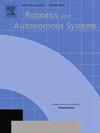冗余控制电缆驱动并联机器人的振动抑制
IF 4.3
2区 计算机科学
Q1 AUTOMATION & CONTROL SYSTEMS
引用次数: 0
摘要
缆索驱动并联机器人(CDPRs)使用柔性缆索将末端执行器连接到固定基座,优先考虑工作空间大和运行速度快的特点,但柔性缆索的存在给 CDPRs 的高精度控制带来了挑战。为了更精确地模拟大工作空间中的 CDPR,需要考虑电缆的质量和弹性。本文使用有限元法对 CDPR 的动态进行建模。为了更准确地预测离散时间模型在实际控制频率下的仿真结果,我们提出了分层模型预测控制(H-MPC)算法,该算法具有用于映射控制信号的内部映射模块和用于预测控制的外部预测模块。在控制过程中,我们设计了一个物理信息神经网络(PINN)来预测端缆元件的状态。在相同的硬件条件下,与模型预测控制(MPC)算法相比,H-MPC 算法能有效减少末端执行器在运行过程中的振动。我们提出的算法在各种轨迹下进行了验证,结果表明 H-MPC 算法可以减轻末端执行器的振动状况。我们为 CDPR 的高精度控制和振动控制研究提供了新的解决方案和思路。我们的 H-MPC 算法也更容易部署到工业控制中。本文章由计算机程序翻译,如有差异,请以英文原文为准。
Vibration suppression of redundantly controlled cable-driven parallel robots
Cable-driven parallel robots (CDPRs) use flexible cables to connect the end-effector to a fixed base, which is prioritized for large workspace and fast operation speed, but the presence of flexible cables creates a challenge for high-precision control of CDPRs. The mass and elasticity of the cables need to be considered to model the CDPRs in a large workspace more accurately. In this paper, the dynamics of the CDPRs are modeled using the finite element method. In order to more accurately predict the simulation results of the discrete-time model at the actual control frequency, the hierarchical model predictive control (H-MPC) algorithm is proposed with an internal mapping module for mapping control signals and an external prediction module for predictive control. In the control process, we designed a physics-informed neural network (PINN) to predict the state of end-cable elements. Under the same hardware conditions, the H-MPC algorithm effectively reduces the vibration of the end-effector during operation compared to the model predictive control (MPC) algorithm. Our proposed algorithm is validated under various trajectories, and the results show that the H-MPC algorithm can mitigate the vibration condition of the end-effector. We provide new solutions and ideas for the research in high precision control and vibration control of CDPRs. Our H-MPC algorithms are also easier to deploy in industrial controls.
求助全文
通过发布文献求助,成功后即可免费获取论文全文。
去求助
来源期刊

Robotics and Autonomous Systems
工程技术-机器人学
CiteScore
9.00
自引率
7.00%
发文量
164
审稿时长
4.5 months
期刊介绍:
Robotics and Autonomous Systems will carry articles describing fundamental developments in the field of robotics, with special emphasis on autonomous systems. An important goal of this journal is to extend the state of the art in both symbolic and sensory based robot control and learning in the context of autonomous systems.
Robotics and Autonomous Systems will carry articles on the theoretical, computational and experimental aspects of autonomous systems, or modules of such systems.
 求助内容:
求助内容: 应助结果提醒方式:
应助结果提醒方式:


